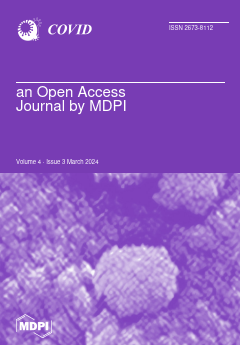Open AccessArticle
Prevalence and Levels of Anti-SARS-CoV-2 Antibodies in the Eswatini Population and Subsequent Severity of the Fourth COVID-19 Epidemic Wave
by
Portia C. Mutevedzi, Vusie Lokotfwako, Gaurav Kwatra, Gugu Maphalala, Vicky Baillie, Lindiwe Dlamini, Senzokuhle Dlamini, Fortune Mhlanga, Tenelisiwe Dlamini, Nhlanhla Nhlabatsi, Marta C. Nunes, Simon Zwane and Shabir A. Madhi
Viewed by 661
Abstract
Background: Seroepidemiology studies are useful for quantifying the magnitude of past infections and estimating the extent of population-based immunity to inform risk mitigation strategies for the future. We report on the only national population-based survey of severe acute respiratory syndrome coronavirus-2 (SARS-CoV-2) immunoglobulin
[...] Read more.
Background: Seroepidemiology studies are useful for quantifying the magnitude of past infections and estimating the extent of population-based immunity to inform risk mitigation strategies for the future. We report on the only national population-based survey of severe acute respiratory syndrome coronavirus-2 (SARS-CoV-2) immunoglobulin G (IgG) seroprevalence in Eswatini. Methods: The survey was undertaken from 31 August to 30 September 2021, following three earlier waves of coronavirus disease (COVID-19), and preceded the onset of the fourth wave, which was dominated by the Omicron variant of concern. We also report on epidemiological trends of recorded COVID-19 cases and hospitalizations before and after the fourth COVID-19 wave through to March 2022. We evaluated the immunoglobulin G (IgG) seropositivity based on either anti-nucleocapsid (N) or anti-spike (S) antigens. Results: Of 4564 individuals, 58.5% were female, 36.0% were aged 18–50 years, and 863 (18.9%) of adults who were older than 18 years had received at least a single dose of COVID-19 vaccine. Overall, 2769 (60.7%) were seropositive with heterogeneity across sub-regions (53.7%; 95% CI:49.2–58.1 to 68.6%; 95% CI:64.5–72.4), with the highest rates occurring in sub-regions of the Manzini region. Seropositivity was higher in vaccinated individuals (84.5%; 95% CI: 81.9–86.7) compared to unvaccinated individuals (55.1%; 95% CI:53.5–56.7). Amongst unvaccinated individuals, seropositivity was highest in 18–50-year-olds (59.5%;95% CI: 56.9–62.1). Seropositivity was associated with female gender, previous positive SARS-CoV-2 NAAT status and being vaccinated, non-smoking, and being formally employed. We estimated as of 15 September 2021 that there had been 639,475 SARS-CoV-2 infections (95% CI; 620,824–658,003) in Eswatini, which was 25.5-fold greater than the 25,048 COVID-19 cases that had been recorded by then. The national case fatality rate (CFR) based on recorded cases was 4.8%, being 25-fold greater than the infection fatality rate (0.19; 95% CI: 0.18–0.19) based on recorded deaths and extrapolating the force of infection from seroprevalence. Nationally and across all four regions, we report the decoupling of COVID-19 cases from hospitalisations and deaths, observed as early as during the third wave, which was dominated by the Delta variant compared with earlier waves. Conclusions: We identified that 60.7% of people in Eswatini had been infected by SARS-CoV-2 at least once and before the onset of the Omicron wave in mid-November 2021. Despite a modest uptake of COVID-19 vaccines, the evolution of population immunity from infection has likely contributed to the decoupling of infection and severe COVID-19 in Eswatini.
Full article
►▼
Show Figures





